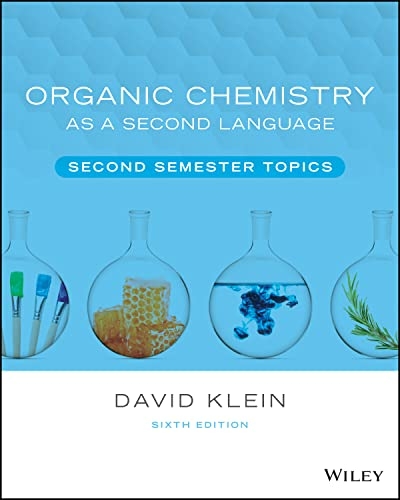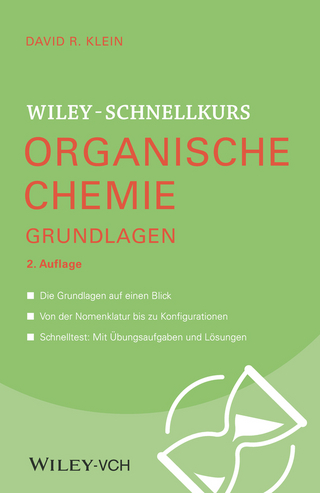
Organic Chemistry as a Second Language
John Wiley & Sons Inc (Verlag)
978-1-119-83705-3 (ISBN)
- Titel z.Zt. nicht lieferbar
- Versandkostenfrei
- Auch auf Rechnung
- Artikel merken
Organic Chemistry as a Second Language: Second Semester Topics, 6e builds on the principles explored in the first half of the course, delving deeper into molecular mechanisms, reactions, and analytical techniques. Using Klein’s one-of-a-kind SkillBuilder approach, the book includes hands-on exercises and thoroughly explained solutions designed to further reinforce student comprehension of chemical concepts and organic principles. An indispensable supplement to the primary text, this resource covers aromatic compounds, infrared (IR) and nuclear magnetic resonance (NMR) spectroscopy, nucleophilic and electrophilic aromatic substitution, ketones and aldehydes, carboxylic acid derivatives, and much more.
Organic Chemistry as a Second Language: Second Semester Topics, 6e teaches students how to ask the right questions to solve problems, study more efficiently, and learn to speak the language of organic chemistry. Like its first-semester companion title, it is an essential ‘guide on the side’ for any organic chemistry student no matter what textbook or instructor-provided lecture material is used. The inclusion of new end of chapter problems, providing both practice and challenge, will prepare students and build confidence come exam time, as well as outside the classroom.
David Klein is a lecturer at Johns Hopkins University where he teaches Organic and General Chemistry. He is a dynamic and creative teacher and uses analogy to help students grasp difficult topics. Klein's unique informal voice and manner of presentation help students truly master key topics in this course. He is also the author of Organic Chemistry as a Second Language; response to this book has been phenomenal.
CHAPTER 1 AROMATICITY ... 1
1.1 Introduction to Aromatic Compounds ... 1
1.2 Nomenclature of Aromatic Compounds ... 2
1.3 Criteria for Aromaticity ... 6
1.4 Lone Pairs ... 9
End-of-Chapter Problems ... 11
CHAPTER 2 IR SPECTROSCOPY ... 14
2.1 Vibrational Excitation ... 14
2.2 IR Spectra ... 16
2.3 Wavenumber ... 16
2.4 Signal Intensity ... 21
2.5 Signal Shape ... 22
2.6 Analyzing an IR Spectrum ... 29
End-of-Chapter Problems ... 36
CHAPTER 3 NMR SPECTROSCOPY ... 39
3.1 Chemical Equivalence ... 39
3.2 Chemical Shift (Benchmark Values) ... 42
3.3 Integration ... 47
3.4 Multiplicity ... 50
3.5 Pattern Recognition ... 52
3.6 Complex Splitting ... 54
3.7 No Splitting ... 55
3.8 Hydrogen Deficiency Index (Degrees of Unsaturation) ... 56
3.9 Analyzing a Proton NMR Spectrum ... 59
3.10 13C NMR Spectroscopy ... 63
End-of-Chapter Problems ... 65
CHAPTER 4 ELECTROPHILIC AROMATIC SUBSTITUTION ... 78
4.1 Halogenation and the Role of Lewis Acids ... 79
4.2 Nitration ... 83
4.3 Friedel–Crafts Alkylation and Acylation ... 85
4.4 Sulfonation ... 92
4.5 Activation and Deactivation ... 96
4.6 Directing Effects ... 98
4.7 Identifying Activators and Deactivators ... 107
4.8 Predicting and Exploiting Steric Effects ... 117
4.9 Synthesis Strategies ... 124
End-of-Chapter Problems ... 129
CHAPTER 5 NUCLEOPHILIC AROMATIC SUBSTITUTION ... 134
5.1 Criteria for Nucleophilic Aromatic Substitution ... 134
5.2 SNAr Mechanism ... 136
5.3 Elimination–Addition ... 142
5.4 Mechanism Strategies ... 148
End-of-Chapter Problems ... 151
CHAPTER 6 KETONES AND ALDEHYDES ... 154
6.1 Preparation of Ketones and Aldehydes ... 154
6.2 Stability and Reactivity of C=O Bonds ... 157
6.3 H-Nucleophiles ... 159
6.4 O-Nucleophiles ... 164
6.5 S-Nucleophiles ... 174
6.6 N-Nucleophiles ... 176
6.7 C-Nucleophiles ... 184
6.8 Exceptions to the Rule ... 193
6.9 How to Approach Synthesis Problems ... 197
End-of-Chapter Problems ... 203
CHAPTER 7 CARBOXYLIC ACID DERIVATIVES ... 207
7.1 Reactivity of Carboxylic Acid Derivatives ... 207
7.2 General Rules ... 208
7.3 Acid Halides ... 212
7.4 Acid Anhydrides ... 220
7.5 Esters ... 222
7.6 Amides and Nitriles ... 231
7.7 Synthesis Problems ... 240
End-of-Chapter Problems ... 247
CHAPTER 8 ENOLS AND ENOLATES ... 253
8.1 Alpha Protons ... 253
8.2 Keto-Enol Tautomerism ... 255
8.3 Reactions Involving Enols ... 259
8.4 Making Enolates ... 262
8.5 Haloform Reaction ... 265
8.6 Alkylation of Enolates ... 268
8.7 Aldol Reactions ... 272
8.8 Claisen Condensation ... 278
8.9 Decarboxylation ... 285
8.10 Michael Reactions ... 292
End-of-Chapter Problems ... 299
CHAPTER 9 AMINES ... 303
9.1 Nucleophilicity and Basicity of Amines ... 303
9.2 Preparation of Amines Through SN2 Reactions ... 305
9.3 Preparation of Amines Through Reductive Amination ... 308
9.4 Acylation of Amines ... 313
9.5 Reactions of Amines with Nitrous Acid ... 316
9.6 Aromatic Diazonium Salts ... 319
End-of-Chapter Problems ... 322
CHAPTER 10 DIELS–ALDER REACTIONS ... 325
10.1 Introduction and Mechanism ... 325
10.2 The Dienophile ... 328
10.3 The Diene ... 329
10.4 Other Pericyclic Reactions ... 335
End-of-Chapter Problems ... 336
Detailed Solutions ... S-1
Index ... I-1
| Erscheinungsdatum | 06.03.2024 |
|---|---|
| Verlagsort | New York |
| Sprache | englisch |
| Maße | 201 x 252 mm |
| Gewicht | 885 g |
| Themenwelt | Naturwissenschaften ► Chemie ► Organische Chemie |
| ISBN-10 | 1-119-83705-7 / 1119837057 |
| ISBN-13 | 978-1-119-83705-3 / 9781119837053 |
| Zustand | Neuware |
| Informationen gemäß Produktsicherheitsverordnung (GPSR) | |
| Haben Sie eine Frage zum Produkt? |
aus dem Bereich


